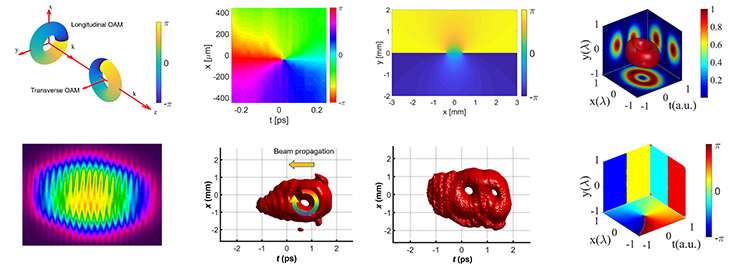 Left: Schematic for spatio-temporal optical vortex (STOV) with transverse OAM and spatial vortex with longitudinal OAM (top), and interference fringes showing phase structure of the generated STOV (bottom). Center left: Reconstructed phase for the STOV (top), and reconstructured 3D intensity distribution for the STOV (bottom), from ref. 1. Center right: Phase and intensity distribution for wavepacket with temporally varying OAM, from ref. 2. Right: Subwavelength focusing of STOV: 3D intensity of focused STOV (top), and corresponding phase projections (bottom), from ref. 3.
Left: Schematic for spatio-temporal optical vortex (STOV) with transverse OAM and spatial vortex with longitudinal OAM (top), and interference fringes showing phase structure of the generated STOV (bottom). Center left: Reconstructed phase for the STOV (top), and reconstructured 3D intensity distribution for the STOV (bottom), from ref. 1. Center right: Phase and intensity distribution for wavepacket with temporally varying OAM, from ref. 2. Right: Subwavelength focusing of STOV: 3D intensity of focused STOV (top), and corresponding phase projections (bottom), from ref. 3.
Photons carry angular momentum, including spin angular momentum (SAM) associated with a rotating polarization vector and orbital angular momentum (OAM) linked to spiral phase. The added degree of freedom from photonic angular-momentum states has spurred substantial theoretical and experimental research, with broad applications in both classical and quantum optics. Longitudinal SAM and OAM with angular momenta parallel to the Poynting vector are commonly studied. Transverse SAM has also recently gained attention, however, in studies of tightly focused beams and evanescent waves.
While recent theoretical studies have revealed the existence of transverse optical OAM, suitable experimental tools to controllably generate light with these OAM states have been lacking. This year, we overcame this limitation by demonstrating a method in which a spiral phase is formed in the spatial frequency–frequency domain, and then retained in the spatio-temporal domain after a 2D spatio-temporal Fourier transform.1 The generated spatio-temporal optical vortex (STOV) resembles a fast-advancing cyclone, with transverse OAM perpendicular to the propagation direction.
The simple and extremely flexible generation method that we have developed opens, we believe, an entirely new direction of photonic-angular-momentum studies for optical and photonic designs. By redesigning the phase pattern to be loaded on the spatio-temporal domain, we were able to demonstrate a wave packet embedded with time-varying transverse OAM with sub-ps temporal separation.2 The ultrafast temporal OAM variation should be applicable to high-speed optical communications and ultrafast manipulation of nanostructures.
The ability to localize such light–matter interaction is crucial for these applications. However, a spatio-temporal astigmatism effect emerges when a spatio-temporal wave packet is focused through a high-numerical-aperture objective lens, collapsing the spatio-temporal vortex. Using an analogy to the cylindrical-lens mode converter used to generate spatial OAM, we were able to realize a subwavelength STOV with transverse OAM by preconditioning the wave packet with both phase and amplitude modulations.3
We anticipate that these studies will spur more research into this nascent area, and open new avenues in myriad applications, including microscopy, plasma physics, laser machining and quantum information processing.
Researchers
Jian Chen and Chenhao Wan, University of Shanghai for Science and Technology, Shanghai, China
Andy Chong and Qiwen Zhan, University of Dayton, OH, USA
References
1. A. Chong et al. Nat. Photon. 14, 350 (2020).
2. C. Wan et al. Sci. Bull. 65, 1334 (2020).
3. J. Chen et al. Opt. Express 28, 18472 (2020).
